Natural yogurts normalize the digestive tract, strengthen immunity, maintain beauty and youth. Discover which yogurts are the healthiest, take delicious recipes with them and lose up to 1 kg per day!
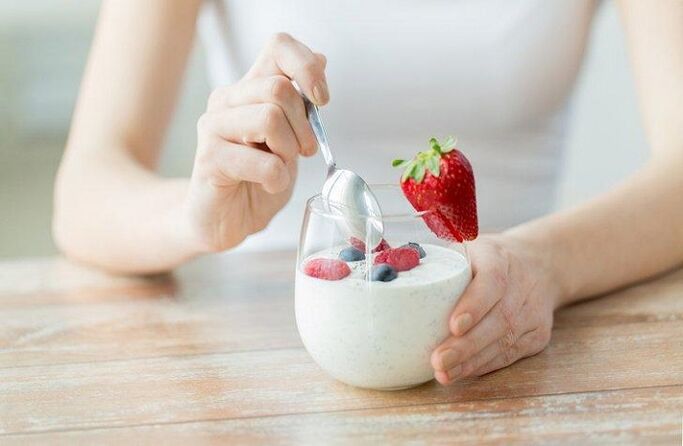
A diet based on bifidobacteria is rightly considered one of the healthiest. Anyone who has experienced the benefits of yogurt at least once will never throw that magical product off their menu. A diet based on fermented milk miracle helps to lose extra pounds in a fairly short time, providing energy along the way and improving digestion. There may not be a single organ system that would not experience positive changes by systematically including yogurt in the diet.
The uniqueness of fermented dairy product lies in its saturation with nutrients. All are easily digestible: compared to cow’s milk, yogurt absorbs 60% of the more beneficial components. At the same time, this drink does not contain milk sugar, which affects the figure better than the use of low-fat dairy products. And bifidobacteria are direct catalysts in calcium absorption, which is often used in therapy during the recovery of calcium deficiency. This type of diet is beneficial for those who are lactose intolerant and cannot afford to drink milk: fermented proteins do not cause lactose intolerance.
With a low-calorie product, the list of vitamins and minerals is amazing. It’s hard to find an equivalent on a gastronomic list that shows such high nutritional value.
What are the useful substances in yogurt
- A protein that contains all kinds of essential amino acids.
- Carbohydrates.
- Rich mineral composition: calcium (approximately 400 mg per cup), phosphorus (participates in the formation of cell structures and as a building material for tooth enamel and bone tissue), fluorine, chromium, cobalt, molybdenum, iodine, sulfur, zinc, iron, chlorine, sodium, etc.
- Vitamins B1, B2, B5, B6 and B12, PP, A, D.
- Bifidobacteria and lactobacilli.
Influence of fermented dairy products based on bifidocultures on health
- Condition of the gastrointestinal tract.Lactobacilli actively colonize the intestines, displacing pathogenic bacteria. This property is often used in antibiotic treatment and in the prevention of dysbiosis. In addition, bifidobacteria eliminate the risk of diarrhea, constipation, increased gas production, and are also considered one of the factors that prevent the development of bowel cancer; with increased acidity or chronic digestion, alleviate the condition and relieve pain.
- Neutralization and removal of toxins.Lactic acid lowers the pH response in the gut, and rotting microorganisms that release toxic waste products within the gastrointestinal tract do not survive in such an environment. This prevents constant endogenous poisoning of the body, which has a great impact on both the processes of digestion and the general well-being of man.
- Improving blood count.Regular intake of the product balances the ratio of blood elements, stimulates the renewal of the main structures: lymphocytes, erythrocytes and cytokines. It also reduces the possibility of sudden jumps in blood pressure in people with hypertension.
- Immune system.Systemic intake of bifidobacteria increases the number of killer cells and interferon gamma, which block the development of viruses, benign and malignant formations.
- Musculoskeletal system.The risk of osteoporosis is significantly reduced due to the high content of calcium, which is more completely absorbed than calcium from any other dairy products.
- Reproductive system.The bacteria contained in yogurt successfully fight against the cause of vaginal thrush - the bacterium Candida Albucans, successfully competing with it for the environment and squeezing it out of the body's microflora.
- Beauty and youth.The structure of the nail plates is strengthened; due to the neutralization of toxins in the intestines, the skin becomes cleaner, pustular rash and allergic rash appear less frequently; hair loss is minimized.
Which yogurts are healthier?
Yogurt is a product of milk fermentation after pasteurization, during which all potential pathogenic microbes are killed. In the second phase of the preparation technology, a culture in the form of sourdough is added to the milk and fermentation takes place in a warm environment. The longer the heat retention time, the more acidic and dense the finished product will become due to the lactic acid-producing bacteria.
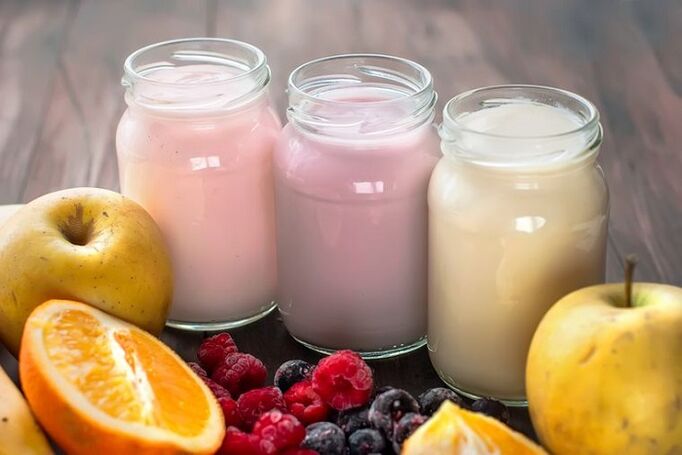
The best option for a yogurt diet would be to use a natural homemade dessert with fermented milk, as its benefits directly depend on the shelf life: the second day after cooking the number of beneficial bacteria drops by half, and so on in arithmetic progress. Therefore, it is best to drink yogurt that is not older than 3 days. You can cook it at home using a yogurt maker or in a slow cooker. Sometimes without the use of special equipment, simply maintaining the desired temperature in a carefully wrapped container or in a thermos. By using a home-made product, you can be sure of its high quality.
Products purchased at a bifidobacteria store do not always meet these requirements. In order to increase their shelf life, special components are added to the fermented product - stabilizers, preservatives. Pieces of fresh fruit are not used as this would immediately cause acidity. Instead, they use canned berries or fruits, in the worst case, only syrups or flavoring agents. That is why they are not so useful, and sometimes they even cause allergic reactions.
To me
Normalization of the microflora is a prerequisite for any diet. In the case of the use of this fermented milk product, this point is completely fulfilled. In addition, due to the high nutritional value, there is no danger of losing essential nutrients during weight loss. For this reason, even during a fairly strict diet, weakness and exhaustion will not be felt.

A prerequisite for a yogurt diet is the daily use of a fermented milk product rich in lactobacilli, in an amount of at least 500 g. The total amount is divided into portions according to the requirements of a particular diet.
On the days of the yogurt diet, you can drink a lot of pure non-carbonated mineral water, green tea, herbal infusions, rosehip soup. Of course, adding sugar to drinks should be avoided. Of the fruit juices, pomegranate, orange, grapefruit, cherry, pineapple and apple are preferred. It is best to prepare them at home from seasonal fruits just before consumption and without pulp - the clarification frees the diet from the increased content of pectin substances. Since these juices contain a lot of fruit acids, which can irritate the intestinal walls and contribute to the feeling of hunger, it is better to dilute them with water in a ratio of 1: 1.
The ideal option would be the preparation of vegetable juices: such drinks are the most useful and caloric. For example, cucumber and celery juice is perfect.
Drinking alcohol is not recommended. In extreme cases, you can use the least dry red wine (better than natural wine, whose producer does not doubt).
3 days
A strict version of the yogurt diet, which borders on stiffness with the effect of fasting. Weight loss during this period will be 1 kg per day. During these 3 days for breakfast, lunch and dinner it is necessary to drink a glass of fermented yogurt, and for lunch, afternoon tea and another dinner to eat 1 large apple. It is necessary to drink at least 2 liters of purified water between meals: this will not only help to overcome hunger during weight loss, but will also provide the body with the necessary amount of fluid to avoid dehydration.

Despite the fact that the diet is limited, hunger will not bother you too much, because fermented milk drinks gently envelop the stomach from the inside, and its mucosa is irritated to a much lesser extent by pepsin.
There is another option for a three-day yogurt diet. At the heart of such a diet is the active use of lactic acid products with bifidobacteria, supplemented with fruit that promotes fat breakdown.
Day 1
- Breakfast: half a cup of natural yogurt, 400 g of melon.
- Lunch: Fruit salad of 1 kiwi, 1 orange and a glass of strawberries with yogurt dressing.
- Dinner: ½ grapefruit, 200 g of cooked chicken fillet, cabbage salad with yogurt dressing.
Day 2
- Breakfast: a portion of muesli with berries on yogurt.
- Lunch: 1/3 medium pineapple, a glass of yogurt.
- Dinner: 3 tangerines, 200 g of cooked turkey breast, lettuce with yogurt dressing.
Day 3
- Breakfast: 300 g of watermelon pulp, a glass of natural yogurt.
- Lunch: banana and strawberry puree with apple juice.
- Dinner: 200 g lean grilled fish, a portion of boiled broccoli, a glass of yogurt.
The heaviest type of yogurt for weight loss, the mono diet, consists exclusively of yogurt in the diet. Its principle is as follows: all 3 days you should drink 600 ml of drink, dividing it into 5 doses. Drink 2 liters of still water every day. It should be noted that this is a rather radical approach to weight loss, but it gives excellent results.
7 days
The main requirement of the child is to drink yogurt half an hour before meals. You cannot drink it with hot drinks, because bifidobacteria are thermophobic and can die under the influence of high temperatures, then the result will be annulled. The drinking regime also changes: you can drink water strictly half an hour before taking yogurt, you cannot drink food. Such a measure will allow you to suppress your appetite before a meal and calmly wait for the main table. Other conditions are standard for all children: avoid fried, greasy, salty, sweet, smoked. It is better to drink it with green or herbal tea, coffee is not desirable.
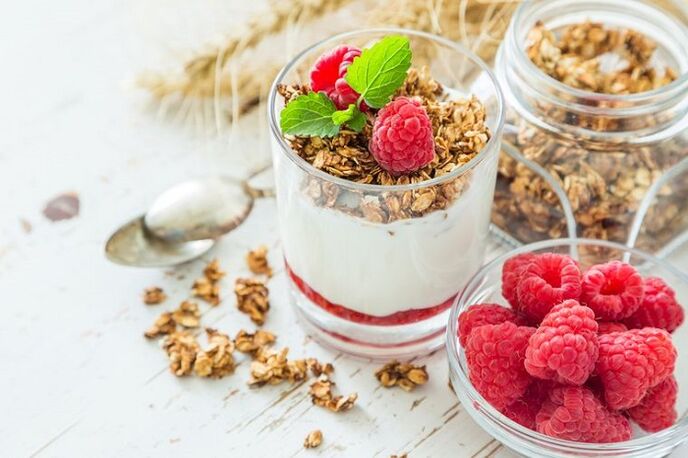
Permitted products include:
- natural unsweetened yogurt;
- fruits and vegetables;
- lean meat;
- lean fish (not fatty varieties);
- cabbage;
- fresh juices;
- green and herbal tea, still drinking water.
On average, you can lose weight in 7 days and become 5 kg lighter.
Monday
- Breakfast: herbal infusion, 2 plums.
- Second breakfast: a glass of yogurt with a handful of muesli, sauerkraut salad.
- Lunch: vegetable soup in zucchini, tomato and cucumber porridge with yogurt dressing.
- Afternoon snack: freshly squeezed clear juice.
- Dinner: 150 g of cod, cucumber, yogurt and fruit dessert.
Tuesday
- Breakfast: half a cup of weak tea, 150 g of berries and fruit jelly.
- Second breakfast: ½ a glass of rosehip juice diluted with water in a ratio of 1: 1.
- Lunch: a portion of yogurt soup, cucumber salad seasoned with yogurt sauce, herbs sprinkled with apple sauce and olive oil, 150 g of boiled navaga, apple juice.
- Afternoon snack: tomato salad with yogurt dressing, a glass of non-carbonated mineral water.
- Dinner: half a cup of unsweetened green tea, boiled asparagus beans, seasoned with yogurt, pomegranate juice, diluted with water.
Wednesday
- Breakfast: rosehip tincture, 3 apricots.
- Second breakfast: a handful of dried fruit, salad with olive oil.
- Lunch: salad of cucumbers, tomatoes, onions and herbs with yogurt dressing, 150 g grilled chicken, a cup of chicken broth, orange juice.
- Afternoon snack: fruit salad, mineral water.
- Dinner: vegetable stew, a couple of apples, green tea without sugar.
Thursday
- Breakfast: 100 g of berries, a handful of dried fruit.
- Second breakfast: 3 pineapple rings.
- Lunch: yogurt soup, 150 g of boiled beef, currant puree and apple puree with yogurt.
- Afternoon snack: a portion of cooked vegetables with yogurt topping.
- Dinner: ½ grapefruit, 150 g grilled almonds, boiled broccoli.
Friday
- Breakfast: herbal infusion, 100 g raspberries, 100 g dried fruits.
- Second breakfast: 200 g shrimp.
- Lunch: vegetable soup, lean rabbit meat - 200 g, tomato and arugula salad with yogurt, lemon juice diluted with water.
- Lunch: fruit salad.
- Dinner: vegetable stew, 100 g of low-fat cottage cheese.
Saturday
- Breakfast: 2 plums.
- Second breakfast: yogurt-based muesli.
- Lunch: yogurt soup, fresh vegetable salad, 2 pieces of feta cheese, apple juice.
- Afternoon snack: 2 kiwis and a cup of green tea.
- Dinner: fresh cabbage salad with lemon juice, orange juice diluted with water.
Sunday
- Breakfast: ½ grapefruit, herbal tea.
- Second breakfast: 200 g of dried fruit.
- Lunch: chicken soup, 200 g of cooked chicken fillet, vegetable salad - 300 g.
- Lunch: 20 grams of any nut (except peanuts).
- Dinner: 3 tbsp. l. buckwheat porridge without salt and oil, 2 tomatoes, pineapple juice.
10 days
The cycle of repetition of such a yogurt diet is not more than 1 time in 1, 5–2 months, otherwise, after a 10-day course, the process of weight loss can be slowed down and even stopped due to getting used to a stable diet. During this time you can lose 4 to 6 kg. The daily calorie intake is around 1100, it is quite balanced and not stressful for the body. However, it is not worth working too much, physical activity should be thoughtful, it is desirable to train in the fresh air. In this case, the process will be much more intense. A nice bonus is that the abundant proteins found in the basic yogurt diet serve as a building block for muscle mass, which will provide strong muscle structure and a lack of laxity, often accompanying the weight loss process.

During this type of diet, a large amount of vegetables and fruits are eaten, however, it should be borne in mind that watermelon, grapes, bananas, melons, pears, potatoes, beets should not be among them, because these representatives Plant life contains a lot of sugar or starch, which can interfere with the required metabolic rate.
General condition for all 10 days: half an hour before each meal you should eat a glass of yogurt.
Dinner should be held at least 3, 5 hours before bedtime.
Approximate meal plan for each day:
- Breakfast: half a cup of warm green, herbal tea or rooibos tea, 150 g of fruit or berry jelly, half a cup of natural juice diluted with water.
- Lunch: yogurt soup, 100 g of chicken, turkey, beef or veal (of your choice), a portion of vegetable salad with herbs, juice diluted with water.
- Afternoon snack: fresh tomato salad with a dressing of yogurt, mustard and a minimum amount of salt, whipped in a blender. Herbal tea.
- Dinner: boiled asparagus beans - 200 g, half a glass of juice with water or a cup of herbal (green) tea.
Diet options
Cottage cheese yogurt
Prepare 600 ml of yogurt and 200 grams of cottage cheese. Divide into 5-6 meals and eat throughout the day. Don't forget water, herbal teas and green tea.
Kefir yogurt
A popular method that has gained recognition as one of the most effective. It is most often used as a post, because there are quite strict restrictions in the product range. The result will be a weight loss of 500-700 g per day.
- Breakfast: 200 g of low-fat kefir.
- Second breakfast: 200 g of regular fatty kefir.
- Lunch: 200 g of natural yogurt.
- Lunch: 200 natural yogurts.
- Dinner: 200 g of natural yogurt.
- Late dinner: 200 g of biokefir.
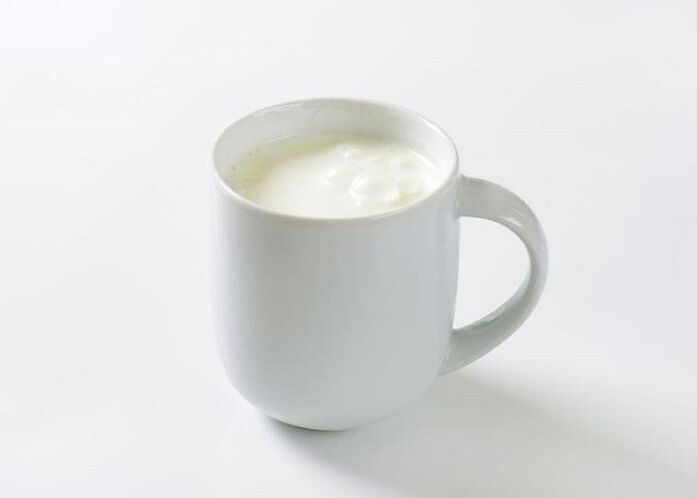
It is necessary to replenish water reserves throughout the day with the help of non-carbonated mineral water or green tea.
Recipes
Dry and liquid sourdough dough most often appear in recipes for the preparation of fermented fermented milk delicacies.
Fluids have a richer yield, which will bring many more health benefits. But, in addition, they have a number of disadvantages: their shelf life is too short, the taste is quite low and the consistency of the finished product is specific: not everyone likes stretching mucus.
Dry starter cultures contain dried bacteria, which "come to life" after being placed in a suitable environment - milk at a given temperature.
In a yogurt factory
If you use homemade milk, you must first boil it to destroy bacteria that can interfere with fermentation during the cooking process. It must then be cooled to room temperature. If you use store-bought milk, you don’t have to cook it.
All dishes that come in contact with milk and sourdough must be perfectly clean.
Put the contents of the bag (ampoule or jar) in the milk and whisk well with a mixer at maximum speed. The more active the whipping process, the more oxygen-saturated the milk will be, which is directly related to the final quality of the product. The fact is that bifidobacteria are aerobic bacteria, ie they actively develop and multiply only in an environment with a sufficient level of dissolved oxygen, and if there is no oxygen, then the death of the culture occurs.
After that, the solution is poured into jars and placed in a yogurt machine and contains the preparation for the time specified in the instructions for fermentation (usually about 7-9 hours). After the required number of hours, the jars with the finished product are removed and placed in the refrigerator for 60 minutes. This measure is needed to stop the intense growth of bacteria. If this rule is not followed, then the reaction of the digestive tract to such a product may be too active, excessive gas formation and bloating in the intestines is possible. After an hour in the refrigerator, the product is completely ready for use.
If desired, just before a meal, you can add pieces of fruit or berries, candied fruit, dried fruit or whisk the yogurt with them in a blender until it becomes a homogeneous mass. It is not recommended to take the additive in advance, as this can cause the acidity of the lactic acid product.
When re-preparing, you can use not sour dough, but existing yogurt at a rate of 150 g per liter of milk.

In the multicooker
All preparation steps are the same as in the case of using yogurt. The mixture is then poured either directly into the multicooker vessel or the jars are placed in the vessel and almost completely filled with water. Then the multicooker is switched on for the required time in the "Yogurt" or "Heating" mode (if in this mode the thermostat produces a temperature not exceeding 40 ° C). After the prescribed time, the finished product, as in the first case, is placed in the refrigerator for 60 minutes, after which it is absolutely ready for use.
In a pot or jar
In this case, the main condition that must be ensured is the long-term maintenance of the temperature inside the vessel. To do this, milk with sourdough, poured into a pot or jar, should be in the range of 38-40 ° C. If the temperature rises above 42 ° C, the bacteria will inevitably die. Then the container is closed and tightly wrapped in several layers with a blanket or terry towel and placed in a warm place (for example, on a radiator). After 7-9 hours, the fermentation process must be stopped by putting yogurt in the refrigerator, after which it can be eaten.
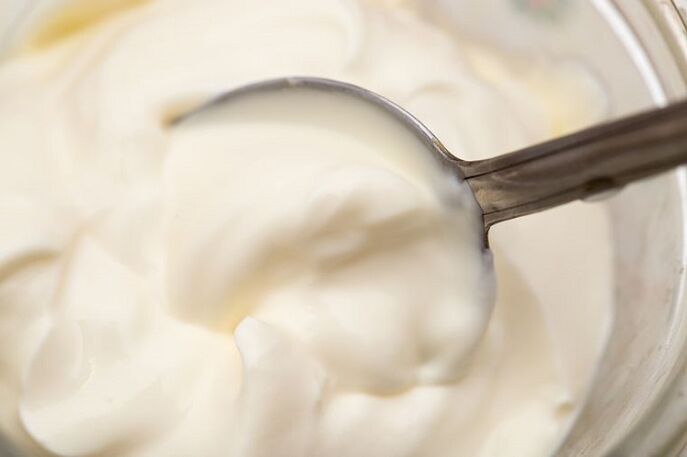
Yogurt soup
This soup is eaten cold and is ideal for summer. Its taste is very unusual, but pleasant, somewhat reminiscent of the well-known okroshka.
Set of ingredients for 3 servings:
- mineral carbonated drinking water - 150 ml;
- chicken eggs - 3 pcs. ;
- medium-sized cucumbers - 1, 5 pcs. ;
- parsley - 0, 5 fresh;
- dill - 0, 5 bundles;
- mustard - ¾ teaspoons;
- raisins - 1, 5 hands;
- salt to taste;
- allspice ground pepper - optional;
- natural yogurt - 375 ml.
Progress in cooking:
- First, wash the raisins and soak in warm water for 10-15 minutes, dry.
- Finely chop the boiled eggs and cucumbers.
- Cut washed and dried greens. Add a few green onion feathers if desired.
- Mix yogurt with mustard, mix thoroughly and add raisins, herbs, cucumbers and eggs.
- Add mineral water, season with salt and pepper. Mix.
- Leave to infuse in the refrigerator for 2-3 hours.
Eat chilled from dryers, soup bowls or wide glasses.
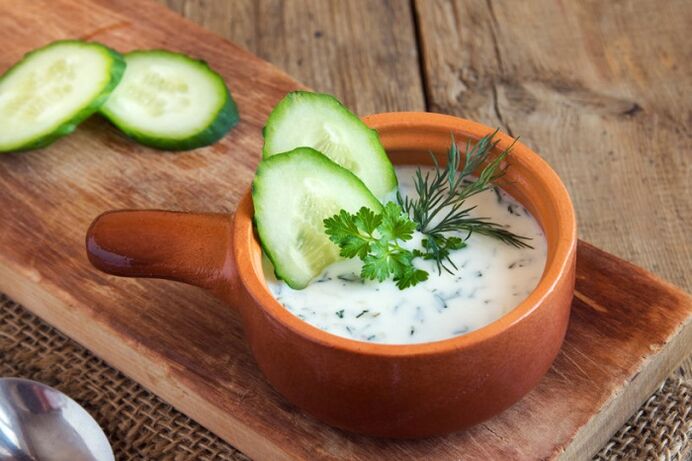
There is another option in which milk is used instead of mineral water, and a clove of garlic and slices of lemon are added as a spice. Before serving, this soup is mashed in a blender and garnished with mint leaves.
Contraindications
Despite the fact that yogurt is a gentle type of diet, there are several contraindications.
- Pathology of the heart and cardiovascular system.
- Diabetes mellitus of any kind.
- Oncological diseases.
- Neuropathological diseases.
- Central nervous system dysfunction.
- Individual intolerance.
- Gastric gastritis with pronounced high acidity.
- Pregnancy.
To make sure there are no contraindications, it is necessary to consult a doctor before starting a diet.































